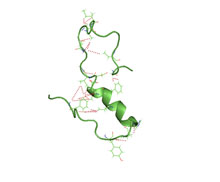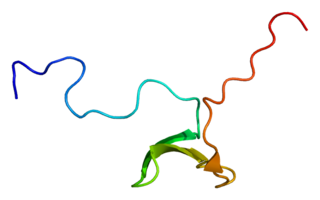Related Research Articles

Lipoprotein lipase (LPL) is a member of the lipase gene family, which includes pancreatic lipase, hepatic lipase, and endothelial lipase. It is a water-soluble enzyme that hydrolyzes triglycerides in lipoproteins, such as those found in chylomicrons and very low-density lipoproteins (VLDL), into two free fatty acids and one monoacylglycerol molecule. It is also involved in promoting the cellular uptake of chylomicron remnants, cholesterol-rich lipoproteins, and free fatty acids. LPL requires ApoC-II as a cofactor.

Apolipoproteins are proteins that bind lipids to form lipoproteins. They transport lipids in blood, cerebrospinal fluid and lymph.

Amyloid beta denotes peptides of 36–43 amino acids that are crucially involved in Alzheimer's disease as the main component of the amyloid plaques found in the brains of people with Alzheimer's disease. The peptides derive from the amyloid precursor protein (APP), which is cleaved by beta secretase and gamma secretase to yield Aβ. Aβ molecules can aggregate to form flexible soluble oligomers which may exist in several forms. It is now believed that certain misfolded oligomers can induce other Aβ molecules to also take the misfolded oligomeric form, leading to a chain reaction akin to a prion infection. The oligomers are toxic to nerve cells. The other protein implicated in Alzheimer's disease, tau protein, also forms such prion-like misfolded oligomers, and there is some evidence that misfolded Aβ can induce tau to misfold.

The low-density lipoprotein receptor gene family codes for a class of structurally related cell surface receptors that fulfill diverse biological functions in different organs, tissues, and cell types. The role that is most commonly associated with this evolutionarily ancient family is cholesterol homeostasis. In humans, excess cholesterol in the blood is captured by low-density lipoprotein (LDL) and removed by the liver via endocytosis of the LDL receptor. Recent evidence indicates that the members of the LDL receptor gene family are active in the cell signalling pathways between specialized cells in many, if not all, multicellular organisms.
The biochemistry of Alzheimer's disease, one of the most common causes of dementia, is not yet very well understood. Alzheimer's disease (AD) has been identified as a possible proteopathy a protein misfolding disease due to the accumulation of abnormally folded amyloid beta (Aβ) protein in the brain. Amyloid beta is a short peptide that is an abnormal proteolytic byproduct of the transmembrane protein amyloid precursor protein (APP), whose function is unclear but thought to be involved in neuronal development. The presenilins are components of proteolytic complex involved in APP processing and degradation.

Low density lipoprotein receptor-related protein-associated protein 1 also known as LRPAP1 or RAP is a chaperone protein which in humans is encoded by the LRPAP1 gene.

Low-density lipoprotein receptor-related protein 8 (LRP8), also known as apolipoprotein E receptor 2 (ApoER2), is a protein that in humans is encoded by the LRP8 gene. ApoER2 is a cell surface receptor that is part of the low-density lipoprotein receptor family. These receptors function in signal transduction and endocytosis of specific ligands. Through interactions with one of its ligands, reelin, ApoER2 plays an important role in embryonic neuronal migration and postnatal long-term potentiation. Another LDL family receptor, VLDLR, also interacts with reelin, and together these two receptors influence brain development and function. Decreased expression of ApoER2 is associated with certain neurological diseases.

Low density lipoprotein-related protein 2 also known as LRP2 or megalin is a protein which in humans is encoded by the LRP2 gene.

Low density lipoprotein receptor-related protein 1 (LRP1), also known as alpha-2-macroglobulin receptor (A2MR), apolipoprotein E receptor (APOER) or cluster of differentiation 91 (CD91), is a protein forming a receptor found in the plasma membrane of cells involved in receptor-mediated endocytosis. In humans, the LRP1 protein is encoded by the LRP1 gene. LRP1 is also a key signalling protein and, thus, involved in various biological processes, such as lipoprotein metabolism and cell motility, and diseases, such as neurodegenerative diseases, atherosclerosis, and cancer.

C-jun-amino-terminal kinase-interacting protein 1 is an enzyme that in humans is encoded by the MAPK8IP1 gene.

Low-density lipoprotein receptor-related protein 5 is a protein that in humans is encoded by the LRP5 gene. LRP5 is a key component of the LRP5/LRP6/Frizzled co-receptor group that is involved in canonical Wnt pathway. Mutations in LRP5 can lead to considerable changes in bone mass. A loss-of-function mutation causes osteoporosis-pseudoglioma, while a gain-of-function mutation causes drastic increases in bone mass.

Amyloid beta A4 precursor protein-binding family B member 1 is a protein that in humans is encoded by the APBB1 gene.

Low-density lipoprotein receptor-related protein 6 is a protein that in humans is encoded by the LRP6 gene. LRP6 is a key component of the LRP5/LRP6/Frizzled co-receptor group that is involved in canonical Wnt pathway.

Amyloid beta A4 precursor protein-binding family A member 2 is a protein that in humans is encoded by the APBA2 gene.

Low-density lipoprotein receptor-related protein 1B is a protein that in humans is encoded by the LRP1B gene.

Low-density lipoprotein receptor-related protein 10 is a protein that in humans is encoded by the LRP10 gene.

Nicotinamide riboside kinase 2 is an enzyme that in humans is encoded by the ITGB1BP3 gene.

Collagen alpha-1(XXV) chain is a protein that in humans is encoded by the COL25A1 gene.

Low-density lipoprotein receptor-related protein 4 (LRP-4), also known as multiple epidermal growth factor-like domains 7 (MEGF7), is a protein that in humans is encoded by the LRP4 gene. LRP-4 is a member of the Lipoprotein receptor-related protein family and may be a regulator of Wnt signaling.

Low density lipoprotein receptor-related protein 3 (LRP-3) is a protein that in humans is encoded by the LRP3 gene.
References
- ↑ Quinn KA, Pye VJ, et al. (1999). "Characterization of the soluble form of the low density lipoprotein receptor-related protein (LRP)". Exp. Cell Res. 251 (2): 433–441. doi:10.1006/excr.1999.4590. PMID 10471328.
- ↑ Quinn KA, Grimsley PG, et al. (1997). "Soluble low density lipoprotein receptor-related protein (LRP) circulates in human plasma". J. Biol. Chem. 272 (38): 23946–23951. doi: 10.1074/jbc.272.38.23946 . PMID 9295345.
- ↑ "Draining away brain's toxic protein to stop Alzheimer's" . Retrieved 2007-10-25.
- ↑ Sagare A, Deane R, et al. (2007). "Clearance of amyloid-beta by circulating lipoprotein receptors". Nat. Med. 13 (9): 1029–1031. doi:10.1038/nm1635. PMC 2936449 . PMID 17694066.